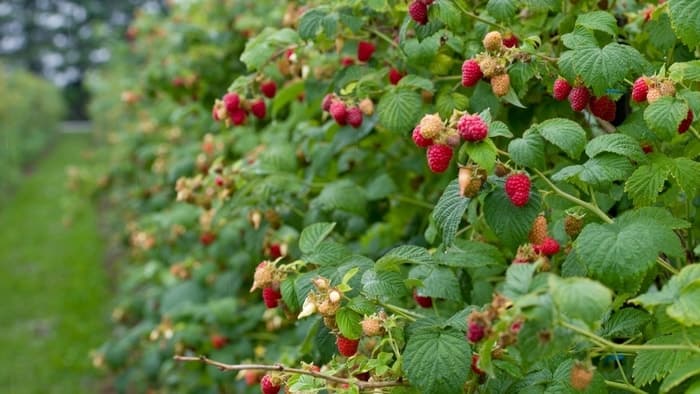Last Updated on January 25, 2022 by
Raspberries are the most straightforward fruit to grow, but most gardeners wonder, how many raspberry canes do I need to give a good yield?
Raspberries are easy to grow and produce very forgiving fruits, and despite all errors, you will still harvest a few kilos.
If you have any unused area in your garden covered in grass and you don’t have time to mow, slash and plant raspberry canes. A year later, you will be enjoying raspberry jam and other recipes courtesy of your homegrown berries.
How Many Raspberry Canes Do I Need?
Raspberries grow and multiply very fast and comprehensively. If you plant one cane this year, you will have a dozen more in the same spot in the coming year. This means you need anywhere between one to ten canes if you have enough space to allow them to grow.
These plants are happy plants procreating by underground runners and producing impressive numbers of healthy new plants.
No farmer is sad to see all these raspberries procreating through underground runners unless you planted your canes where you did not want them to spread. You can share your canes among friends to encourage more raspberries production.
How Much Spacing Do I Need to Allow Raspberry Bush Enough Space?
When planting, at least two rows allow enough room for your raspberries to flourish. Allow 9 to 10 feet wide for growth and more elbow room for picking between the rows.
Learn more about: How Big Do Raspberry Bushes Get?
When Is The Best Time to Plant Raspberry Canes?
The best time to plant your raspberry canes is early spring. However, some can be planted in the summer if you get your canes during this season.
Spring canes establish better giving much healthier berries. Their first crop is a few berries in their first summer.
Before planting, soak your canes in a solution to strengthen them. Use ½ a teaspoon of vitamin B1 growth stimulant per quart water. Soak these canes for about 6 hours to give them a healthy start.
Don’t soak your canes longer than a day in the B1 solution because they will die quickly. Plant them immediately to avoid delay and destruction.
If you receive dormant canes in the mail, store them in the fridge to keep them dormant as you prepare your planting grounds.
Tips to Help You Plant Your Raspberry Canes
Do thorough research. Before you plant any of your raspberry canes, it’s best to find out all the information you don’t know about them. Find out what type of soil this plant needs, how to plant the canes correctly, how to choose the right raspberry plant, and anything else you may want to know. The research will help you decide which types of raspberries will best suit your location and needs.
Soak your cane before planting. Just as we have explained above, it is advisable to soak your canes for a couple of hours before planting – especially if the roots seem dry. This process kick starts your growth process.
Choose the right planting location. Raspberries grow in most soil types but not in all locations. Avoid planting them in wet or windy areas as they do not thrive here.
Give your raspberries light. Raspberries don’t need full sun to thrive; they also do well in partial shade. However, if you grow them under the full sun, you will get more raspberries to produce.
Compost. Use compost when planting raspberry canes. Spread a couple of inches of compost on the topsoil to help add nutrients and improve your raspberry yields.
Mulch. Mulch the base of the raspberry to insulate the roots during the cold season and keep the weeds from growing. Raspberries have shallow roots, so weeding is discouraged and if you weed, do it carefully. Mulching keeps you from weeding.
Give them enough growing space. Raspberries spread very wide; that’s why you should leave enough room for their growth. Give them at least 3 feet apart in rows and 8 feet apart from one plant to another. Don’t plant raspberry canes in the middle of your vegetable garden because it will soon take over, and you will lose your vegetables.
Prune your raspberry plants. After fruiting, cut down the old raspberry canes and leave the new ones to continue growing. Fall fruiting varieties should be cut to the ground in early winter or as soon as they finish fruiting to prepare them for further growth. Pruning is essential as it increases your yields in the coming season. It will take you only a few minutes, but it’s an important exercise.
Don’t plant your raspberries near fences or other areas that will hinder your harvesting or pruning. This will encourage wild growth with less produce.
Regular watering is critical. Water your raspberries right from the beginning to give them a good start. Water them one inch per week from spring until after harvest.
Provide support. Your plants will grow tall, and supporting them will help them remain upright. Many varieties will grow as tall as you; use bamboo or trellis support to hold up your canes and make picking easier.
Conclusion
Now that you know how many canes you need to grow to get the harvest, we need to go ahead and try it.
It is crucial that you not establish your raspberry patch in an area where tomatoes, potatoes, and peppers avoid verticillium wilt. These vegetables carry this disease and spread it to raspberries if you plant them in the same spot.
There are two types of raspberries – summer-fruiting and fall-fruiting. Mixing both the summer and fall types is a great way to maximize your harvest period.
Don’t forget to look up new recipes to try out with your fresh raspberry produce. Use them to make desserts of all kinds, ice cream topping, layering fancy cakes with mashed berries and chocolate, bumbleberry pies.
If your berries are too much, you can go ahead and freeze your raspberries so you can use them all winter. Freezing raspberries is easy. Clean the firm berries on a cookie sheet and put them in the freezer. When frozen, roll them nicely into zip lock bags to safely keep them. The sweetest berries are from the summer and will retain their sweetness all through.
FAQs
How far apart should you plant raspberry canes?
First, you should try to keep the canes free of weeds as much as possible so that they have plenty of room to grow. In areas with hot, dry weather, you may want to water your canes a little more frequently than usual.
The distance between the canes depends on a number of factors, including the type of soil, the weather conditions during the growing season, and how often you will be picking berries. If you are planning to grow your own canes for berry production, the most important thing to consider is the variety you choose.
In my experience, the answer to this question is: as far apart as you can manage. The reason is that, at first, they will grow quite close together and will compete with each other for space and nutrients. The second thing is that the root system of a raspberry cane needs room to spread out and it will do this by growing along the ground.
This means that when you have several canes, they will all grow in a row, side-by-side, just a few inches apart. There are two ways of growing canes: either you start them from seed or you start them from plants grown from canes. You can buy seed canes online, or you can grow your own.
You will need to get the seeds before you start growing canes. This is because if you buy the seed cane and then plant it, it will not produce a viable cane. Instead of buying seed canes, you can grow your own. To grow your own, you can take cuttings from the existing canes or buy a cane and plant it yourself.
Do raspberry canes spread?
In my experience, the easiest way to propagate raspberry canes is from cuttings. Raspberries are a fruit that is very easy to propagate from cuttings. The only thing you need to do is to make sure that the cuttings are in a moist environment. After you have made the cuts, you need to keep them moist until they begin to sprout. You can use any type of soil for rooting your cuttings.
When should I plant raspberry canes?
Raspberries are generally planted in the fall, about 10-15 days before frost. If you have a warm climate, they will likely fruit all winter long. In cooler climates, they usually only fruit for about 2 months. You can start them from seed or cuttings. They should be started in the fall and then will overwinter and fruit all winter.
How do you train raspberry canes?
I have been able to get them to produce fruit by planting them in a container, cutting the cane into sections and then placing those sections in individual containers. I then fertilize and water them. The cane will eventually become root bound and then it's just a matter of time until they produce fruit.
Do you split raspberry canes?
I don't split my raspberries, but it's really a personal preference. I like to have a few varieties of berries and so I usually pick several when I go out to the garden. However, you can split them if you want to. If you're using a pruning saw, just cut them in half.
When can I move raspberry canes?
I think you need to wait until the raspberries are fully ripe before you transplant them, otherwise they will not grow well. You can take the fruit off of the plants once they are ripe, or you can let them stay on the plant as long as they are still green and the fruits are still hard.
Caroline is a gardener who loves to get down to the nitty–gritty of gardening. She proudly proclaims herself as a ‘dirt worshipper‘ and can often be found deep in the garden, covered in soil and singing to her plants. As a self–proclaimed ‘plant whisperer‘, Caroline believes that plants need love and attention just like any other living thing, and she loves to give them both. When she‘s not tending to her garden, you can often find her researching the latest gardening trends, or teaching others how to make their gardens thrive



